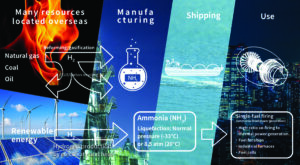
APL is working with Japanese researchers to justify co-firing of ammonia. (Image: NEDO)
As world leaders gathered in the United Arab Emirates for the U.N. Climate Change Conference (COP 28), Adani Power Ltd. (APL), one of South Asia’s largest private sector power generators, announced a ground-breaking green ammonia combustion pilot project at its Mundra power plant in India as part of a multipronged decarbonization initiatives.
As part of the project, the Mundra power plant, which is one of South Asia’s largest private sector power plants, will co-fire up to 20% green ammonia in the boiler of a conventional coal-fired, 330-MW unit.
Green ammonia, produced from green hydrogen, which in turn is produced through electrolysis using renewable energy, would be a feedstock for the boilers. As ammonia contains no carbon, there is no CO2 emission from its combustion, making it a long-term carbon-neutral alternative to fossil fuels. Adani Power has already set a benchmark in the industry for ‘per-unit’ emissions and has adopted state of the art ‘Ultra Supercritical technology’ for its newest plants.
“Adani Power is fully committed to reducing its carbon footprint through adoption of latest technologies and proactive measures across our business value chain,” said Anil Sardana, managing director, Adani Power Ltd. “In furtherance of this vision, we are happy to partner with IHI and Kowa for blending green ammonia for our Mundra plant, which will reduce CO2 emissions. We will continue to integrate cutting-edge technologies increasingly to reduce emissions in the intermediate term.”
Adani Power has partnered with IHI and Kowa-Japan to deliver the pilot and examine expansion to other APL units and stations as well. Kowa is active in energy-saving and energy-creating products, while IHI is a heavy industry company which has ammonia firing technology. Combustion tests at IHI’s facility in Japan have begun with a 20% ammonia blend, simulating the Mundra power plant’s equipment. The partners believe that the results will be encouraging enough to implement this solution at the Mundra power plant once economic parity is achieved between both feedstocks. The Mundra plant is the first location outside of Japan to have been selected for this cutting-edge green initiative.
The ambitious project has been conceived under the aegis of Japan-India Clean Energy Partnership (CEP), which aims to ensure energy security, achieve carbon neutrality, and achieve economic growth. It has been selected under the New Energy and Industrial Technology Development Organization’s (NEDO) International Demonstration Project for Japanese Technologies Contributing to Decarbonization and Energy Transition. NEDO is Japan’s national research and development agency that fosters innovation by promoting technological development necessary for realization of a sustainable society.
APL is the largest private thermal power producer in India. It generates more than 15,250 MW from coal-fired power plants in Gujarat, Maharashtra, Karnataka, Rajasthan, Chhattisgarh, Madhya Pradesh, and Jharkhand, and a 40 MW solar power project in Gujarat.
Hydrogen and ammonia can be created using coal as a feedstock. Similar to hydrogen, ammonia does not emit CO2 during firing, so it is expected to be used as a zero-emission fuel for power generation and shipping, thereby helping users to achieve carbon neutrality. Ammonia can also be used as a hydrogen carrier, so by using existing infrastructure, it can be manufactured and transported inexpensively. Because of these characteristics, ammonia fuel is attracting attention all over the world, and demand is expected to increase rapidly in the future, especially in Asia.


